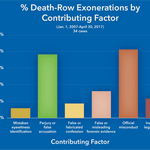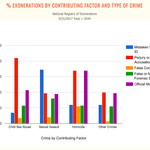The Most Common Causes of Wrongful Death Penalty Convictions: Official Misconduct and Perjury or False Accusation
Many factors contribute to wrongful convictions, and it is no different in capital cases. But the most recent data from the National Registry of Exonerations points to two factors as the most overwhelmingly prevalent causes of wrongful convictions in death penalty cases: official misconduct and perjury or false accusation. As of May 31, 2017, the Registry reports that official misconduct was a contributing factor in 571 of 836 homicide exonerations 68.3%, very often in combination with perjury or false accusation, which also was a contributing factor in 68.3% of homicide exonerations. According to the Registry, mistaken witness identification was present in nearly a quarter of homicide exonerations (203, 24.3%), as was false or misleading forensic evidence (194, 23.2%), and false or fabricated confessions were present in more than a fifth of the exonerations (182, 21.8%). The Registry lists inadequate legal representation at trial as a contributing factor in more than a quarter (218, 26.1%) of these wrongful homicide convictions.
Two reports released on March 7, 2017 by the National Registry of Exonerations, Exonerations in 2016 and Race and Wrongful Convictions in the United States, provide continuing evidence of the role of official misconduct in wrongful capital prosecutions, and suggest a link between race of defendant and official misconduct. The Registry’s annual report on exonerations revealed a record 166 exonerations in 2016 — and a record number of exonerations involving police or prosecutorial misconduct. 54 of the 2016 exonerations — nearly a third — involved wrongful homicide convictions. At least 13 of these cases involved the wrongful use of the death penalty — meaning that the death penalty played a role in nearly a quarter of the 54 homicide exonerations in 2016. Every one of these wrongful convictions involved either official misconduct or perjured testimony/false accusation, and eleven (84.6%) of them involved both. The National Registry’s race report documents that the “rate of official misconduct is considerably higher among murder exonerations with black defendants than those with white defendants, 76% compared to 63%. The rate of misconduct is higher overall in capital cases, and the difference by race is greater: 87% of black exonerees who were sentenced to death were victims of official misconduct, compared to 67% of white death-row exonerees.”
The Death Penalty Information Center has examined our exoneration database and cross-referenced it with the National Registry of Exonerations information on death-row exonerations in the last decade (between 2007 and April 2017) to determine the most common factors that contributed to the wrongful convictions and death sentences for the most recent exonerees. The data for the 34 cases in the NRE database[1] shows that the wrongful capital prosecutions involved more than mere errors. Every one of these cases involved some combination of official misconduct, perjury or false accusation, or false or misleading forensic evidence; and more than three-quarters (26 cases, 76.5%) involved at least two of these factors. Fewer than one-tenth of the cases (3, 8.8%) involved a single wrongful cause. 91.2% (31 cases) had multiple contributing factors and nearly half (16 cases, 47.1%) had three or more contributing causes.

By category, the leading contributing causes of wrongful conviction in the death-row exonerations between 2007 and April 2017 were:
- Official misconduct (28 cases, 82.4%)
- Perjury or false accusation (26 cases, 76.5%)
- False or misleading forensic evidence (11 cases, 32.4%)
- Inadequate legal defense (8 cases, 23.5%)
- False or fabricated confession (6 cases, 17.6%)
- Mistaken eyewitness identification (4 cases, 11.8%)
DPI Exoneration Database with National Registry of Exonerations Causes (Where Available)
| Name | Race | State | Year | Contributing Factors | ||||||
|---|---|---|---|---|---|---|---|---|---|---|
| Rodricus Crawford | B | LA | 2017 | Official Misconduct | False or Misleading Forensic Evidence | |||||
| Isaiah McCoy* | B | DE | 2017 | Official Misconduct | Perjury or False Accusation | |||||
| Derral Wayne Hodgkins*-z | W | FL | 2015 | Appellate acquittal, insufficient evidence | ||||||
| Lawrence William Lee | W | GA | 2015 | Official Misconduct | Perjury or False Accusation | Inadequate Legal Defense | ||||
| Alfred Brown | B | TX | 2015 | Official Misconduct | Perjury or False Accusation | Mistaken Witness ID | ||||
| Willie Manning | B | MS | 2015 | Official Misconduct | Perjury or False Accusation | |||||
| Anthony Ray Hinton* | B | AL | 2015 | False or Misleading Forensic Evidence | Inadequate Legal Defense | Mistaken Witness ID | ||||
| Debra Milke | W | AZ | 2015 | Official Misconduct | Perjury or False Accusation | False Confession | ||||
| Ricky Jackson | B | OH | 2014 | Official Misconduct | Perjury or False Accusation | |||||
| Wiley Bridgeman | B | OH | 2014 | Official Misconduct | Perjury or False Accusation | |||||
| Kwame Ajamu | B | OH | 2014 | Official Misconduct | Perjury or False Accusation | |||||
| Henry McCollum | B | NC | 2014 | Official Misconduct | Perjury or False Accusation | False Confession | ||||
| Leon Brown | B | NC | 2014 | Official Misconduct | Perjury or False Accusation | False Confession | ||||
| Carl Dausch‑z | W | FL | 2014 | Allegations that lab technician falsified DNA swab reports | Appellate acquittal, insufficient evidence | |||||
| Glenn Ford | B | LA | 2014 | Official Misconduct | Perjury or False Accusation | False or Misleading Forensic Evidence | Inadequate Legal Defense | |||
| Reginald Griffin | B | MO | 2013 | Official Misconduct | Perjury or False Accusation | |||||
| Seth Penalver | W | FL | 2012 | Official Misconduct | Perjury or False Accusation | |||||
| Damon Thibodeaux | W | LA | 2012 | Official Misconduct | False Confession | Mistaken Witness ID | ||||
| Joe D’Ambrosio | W | OH | 2012 | Official Misconduct | Perjury or False Accusation | False or Misleading Forensic Evidence | ||||
| Gussie Vann | W | TN | 2011 | False or Misleading Forensic Evidence | Inadequate Legal Defense | |||||
| Anthony Graves | B | TX | 2010 | Official Misconduct | Perjury or False Accusation | False or Misleading Forensic Evidence | ||||
| Robert Springsteen | W | TX | 2009 | Perjury or False Accusation | False Confession | |||||
| Yancy Douglas | B | OK | 2009 | Official Misconduct | Perjury or False Accusation | |||||
| Paris Powell | B | OK | 2009 | Official Misconduct | Perjury or False Accusation | |||||
| Michael Toney | W | TX | 2009 | Official Misconduct | Perjury or False Accusation | |||||
| z‑Herman Lindsey | B | FL | 2009 | 3 concurring justices found penalty-phase misconduct by prosecution | Appellate acquittal, insufficient evidence | |||||
| Ronald Kitchen | B | IL | 2009 | Official Misconduct | Perjury or False Accusation | False Confession | ||||
| Daniel Wade Moore** | W | AL | 2009 | Official Misconduct | ||||||
| Paul House | W | TN | 2009 | False or Misleading Forensic Evidence | ||||||
| Nathson Fields | B | IL | 2009 | Official Misconduct | Perjury or False Accusation | Inadequate Legal Defense | ||||
| Michael Blair | A | TX | 2008 | False or Misleading Forensic Evidence | Mistaken Witness ID | |||||
| Levon “Bo” Jones | B | NC | 2008 | Official Misconduct | Perjury or False Accusation | Inadequate Legal Defense | ||||
| Glen Edward Chapman | B | NC | 2008 | Official Misconduct | Perjury or False Accusation | Inadequate Legal Defense | ||||
| Kennedy Brewer | B | MS | 2008 | Official Misconduct | Perjury or False Accusation | False or Misleading Forensic Evidence | ||||
| Jonathan Hoffman | B | NC | 2007 | Official Misconduct | Perjury or False Accusation | |||||
| Michael Lee McCormick | W | TN | 2007 | False or Misleading Forensic Evidence | Inadequate Legal Defense | |||||
| Curtis McCrory | W | OK | 2007 | Official Misconduct | Perjury or False Accusation | False or Misleading Forensic Evidence | ||||
* Non-unanimous jury recommendation
** Judicial override
-z Appellate acquittal, not in NRE
Official Misconduct: Wrongful Capital Prosecutions and 2016 Exoneration Data
As discussed above, the 2016 data from the National Registry for Exonerations included evidence that the death penalty played a role in nearly a quarter of the 54 homicide exonerations that took place in 2016.
The NRE exoneration data reveals at least 13 exonerations that involved the wrongful use of the death penalty. In at least six of the wrongful homicide convictions, prosecutors had sought the death penalty at trial. In another, an innocent defendant pled guilty to avoid the death penalty. And at least six additional exonerations were the product of witnesses having falsely implicated innocent defendants after police had threatened the witness or a loved one with the death penalty unless the witness cooperated with the investigation.
There were at least six wrongful capital prosecutions in which prosecutors sought death, but juries imposed life:
- Eddie Bolden, IL: Contributing Factors — Mistaken Witness ID, Official Misconduct, Inadequate Legal Defense;
- Keith Harward, VA: Contributing Factors — Mistaken Witness ID, False or Misleading Forensic Evidence, Perjury or False Accusation, Official Misconduct;
- Mark Maxon, IL: Contributing Factors — False Confession, Perjury or False Accusation, Official Misconduct;
- Charles Palmer, IL: Contributing Factors — False or Misleading Forensic Evidence, Perjury or False Accusation;
- Kevin Siehl, PA: Contributing Factors — False or Misleading Forensic Evidence, Perjury or False Accusation, Official Misconduct, Inadequate Legal Defense;
- Anthony Wright, PA: Contributing Factors — False Confession, Perjury or False Accusation, Official Misconduct.
There was at least one case in which the wrongful threat of the death penalty caused an innocent defendant to plead guilty to avoid the death penalty:
- Paul Gatling, NY: Contributing Factors — Mistaken Witness ID, Official Misconduct.
There were at least three other cases, involving six people exonerated in 2016, in which the wrongful conviction was procured by threatening witnesses that they or their loved ones would face the death penalty unless the witness cooperated:
- Carl Dukes and Lavell Jones, NY: Contributing Factors — False Confession, Perjury or False Accusation, Official Misconduct;
- Johnny Small, NC: Contributing Factors — Perjury or False Accusation, Official Misconduct;
- The “Norfolk 4” (3 of whom—Joseph Dick, Derek Tice, and Danial Williams—were exonerated in 2016), VA: Contributing Factors — False Confession, Perjury or False Accusation, Official Misconduct.
Every one of these wrongful convictions involved either official misconduct or perjured testimony/false accusation, and eleven (84.6%) of them involved both.
Race and Official Misconduct in Homicide Cases
The National Registry of Exonerations report on Race and Wrongful Convictions in the United States reveals that 87% of black death-row exonerees had been victims of official misconduct, as compared to 67% of white death-row exonerees. Official misconduct is among the most difficult and time-consuming of evidence to unearth, and so it is not surprising that the most recent exonerations — many of which have taken two decades or more — provide ever starker evidence of race effects. The NRE data shows that 20 of the last 21 wrongly condemned African Americans (95%) to have been exonerated were victims of official misconduct, as compared to 8 of the last twelve white death-row exonerees (67%).
The National Registry reports that these racial disparities are “for the most part” the product of police misconduct. The Registry reports “a modest difference” in prosecutorial misconduct rates by prosecutors in death-row exonerations, with prosecutorial misconduct present in 59% of death-row exonerations of African Americans, as compared to 53% of death-row exonerations of whites. However, it reported “a large difference in the rate of misconduct by police”: 59% for black death-sentenced exonerees compared to 44% for whites. The Registry reports that “[t]he high rate of misconduct by police in murder cases with black defendants is reflected in the nature of the misconduct that occurs. Concealing exculpatory evidence, the most common type, is primarily a form of prosecutorial misconduct; there is relatively little difference in its frequency by race.… On the other hand, witness tampering is committed almost exclusively by police officers” and occurs nearly twice as frequently with black murder defendants.
Comparing Contributing Factors in Homicide Exonerations to Those in Other Types of Crime
Data from the National Registry shows that official misconduct and false confessions are far more prevalent in homicide exonerations than in exonerations for other types of crimes, and that, apart from child sexual abuse, homicide exonerations involve perjury or false accusation much more frequently than do exonerations in other types of cases. Mistaken eyewitness identifications and false or misleading forensic evidence are present to the same degree in homicide cases as is most other types of cases. The exception is exonerations in sexual assault cases, which have significantly higher rates of both mistaken identifications and false or misleading forensic evidence.

Footnotes
1The National Registry does not include in its exoneration database the three appellate acquittals of Florida death-row prisoners that occurred during this period. For inclusion in its exoneration database, NRE requires the subsequent discovery of evidence of innocence, which does not occur when a death-row prisoner’s conviction is overturned and a retrial barred because the evidence was insufficient to convict in the first instance. The appellate acquittal itself is sufficient for inclusion on DPI’s exoneration list.
2Although no one who was sentenced to death was fully exonerated in 2016, the 2016 data from the National Registry for Exonerations included evidence of at least 13 cases that involved the wrongful use of the death penalty, either through wrongful capital prosecutions in which (1) defendants were convicted but avoided the death penalty at sentencing, (2) defendants gave false confessions to avoid facing the death penalty at trial, or (3) witnesses presented false testimony after being threatened that they or a loved one would face the death penalty if they did not cooperate with law enforcement.
—Robert Dunham, Executive Director (May 31, 2017)
Earlier Studies
Note: Nearly half of the cases included more than one reason for a wrongful conviction. Therefore the total of the cases in the chart equals more than 86.
In 2001, the Center on Wrongful Convictions at Northwestern Law School analyzed the cases of 86 death-row exonerees. They found a number of reasons why innocent people are wrongly convicted in capital cases. The reasons included:
- eyewitness error — from confusion or faulty memory.
- government misconduct — by both the police and the prosecution
- junk science — mishandled evidence or use of unqualified “experts”
- snitch testimony — often given in exchange for a reduction in sentence
- false confessions — resulting from mental illness or retardation, as well as from police torture
- other — hearsay, questionable circumstantial evidence, etc.
The Center for Wrongful Convictions report found that, among these earlier cases, eyewitness error was the most common factor in death-row exonerations.
Read the Full Report
Attachment A
Attachment B
Attachment C
For more information about the reasons for wrongful convictions, see:
General:
- Convicting the Innocent: Aberration or Systemic Problem? by Rodney Uphoff, University of Missouri School of Law
- “Exonerations in the United States, 1989 through 2003,” by Samuel Gross, et al., Journal of Criminal Law and Criminology, Vol. 95, No. 2, 2005
Government Misconduct:
- Government Misconduct by the Innocence Project
- Official Misconduct by the Center on Wrongful Convictions
Snitch Testimony:
- The Snitch System by the Center on Wrongful Convictions
- Incentivized Informants by the Innocence Project
Other:
- Inadequate Defense by the Innocence Project
Eyewitness Error:
- Eyewitness Misidentification by the Innocence Project
- Eyewitness Error by the Center on Wrongful Convictions
Junk Science:
- Forensic Science Misconduct by the Innocence Project
- Unreliable and Limited Science by the Innocence Project
- Informants/Snitches by the Innocence Project
False Confessions:
- False Confessions or Admissions by the Innocence Project
- False Confessions by the Center on Wrongful Convictions
For National Registry of Exoneration information on the causes of conviction in cases involving exonerated former death-row prisoners, click here.


